14 Stories That Prove Kindness Can Turn Regular People Into Heroes

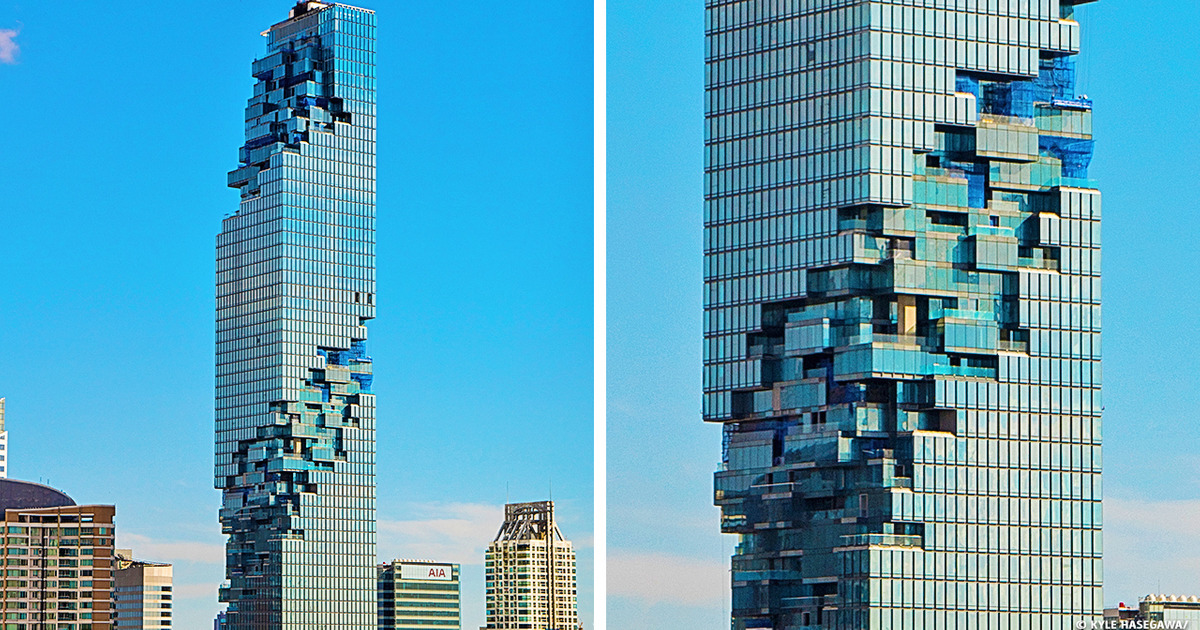
Have you ever seen a skyscraper that can change its shape? The creators of the F&F Tower in Panama City had a concept and only $50 million, which isn’t a lot in skyscraper money. So, they couldn’t afford a mistake, and they finished a concrete structure with the 39 upper floors rotating 9 degrees around an axis from the first attempt without spending any extra time or materials. Dubai’s Rotating Tower will look different every time you see it once it’s finished.
Each of its 80 floors will rotate 360 degrees individually around the center of the building. The lucky residents will be able to control that rotation, which means they can choose their view from the window. A complete lap should take about 90 minutes. And no, the tower won’t be a huge waste of electricity — it will produce its own energy! Wind turbines between the floors will drive the rotations.
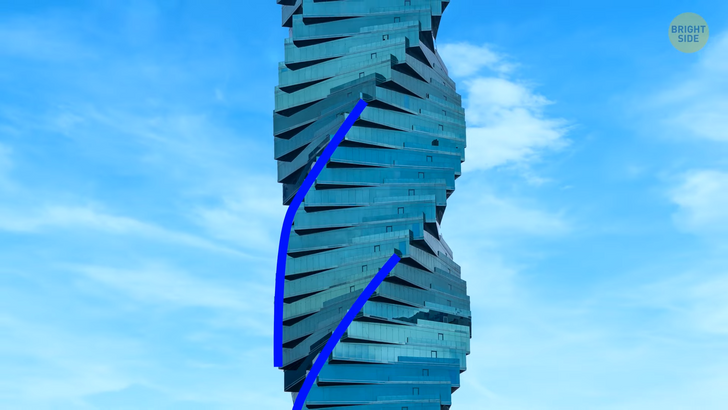
If you’ve ever wanted to live inside a video game, book an apartment in the King Power Mahanakhon [Ma-HA Na-KON] building. This pixelated skyscraper around the height of the Eiffel Tower is the tallest building in Thailand. The secret behind its looks is the horizontally and vertically divided glass windows. It took 5 years to finish this beauty with over 200 apartments, a hotel, luxury shops, restaurants, and one of the most breathtaking viewpoints in the world.
The Liebian International Building features one of the world’s tallest artificial waterfalls running right down its side. No worries, they only turn it on on special occasions, and it uses a mix of recycled tap water and rainwater. When it started running for the first time, the non-informed locals even reported a huge water leak.
The Cybertecture office building in Mumbai looks like a huge egg made of glass and steel. It was actually inspired by a vessel that, like our planet, has its own ecosystem. To bring down the heat levels inside, the architects chose the ideal orientation and added sun shading and an underground cooling system.
The Marina Bay Sands in Singapore seems like a Stonehenge look-alike, but its architect claims that he was inspired by a house of cards. The horizontal one is balanced on the three vertical ones. They are three 55-story hotels with restaurants, nightclubs, gardens, shops, museums, and movie theaters. The horizontal card is an infinity swimming pool with the best view of the city for up to 4,000 visitors. The pool hangs at the height of the 57th floor, and it feels like nothing is holding it.
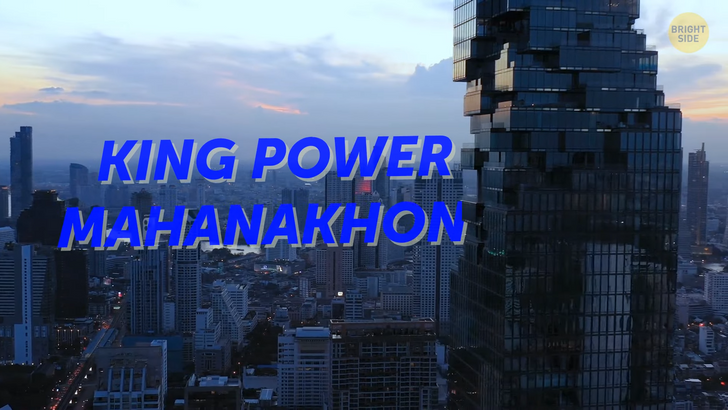
The Dancing House definitely stands out among more traditional architecture in Prague. The nickname for the house is Fred and Ginger. The stone tower symbolizes famous dancer Fred Astaire, and the glass tower — his partner Ginger Rogers. There’s even imaginary hair on top of Fred’s tower. 99 concrete panels support the dancing shape, all of them of different dimensions.
Umeda Sky Building, twice the height of Big Ben, consists of 2 towers of glass and steel to the north of Osaka Station. The Floating Garden Observatory connects the towers on top. Although the building is in a huge city, the skywalk is so high in the clouds that the only thing you’ll hear up there is the wind. If you’re scared of heights, you can visit an urban garden, a theater, an art museum, or one of the many offices closer to the ground inside the building.
Architect Octavio Mendoza owns probably the largest piece of pottery in the world. If you’re ever in Colombia, ask the locals for directions to the Flinstone House — yes, they call it that for a reason. The official name is Casa Terracota, and the architect only used clay to build it. He let it bake and harden in the sun, which transformed the pliable material into solid ceramic. Every curve of the building is designed after the surrounding hills. All the furniture inside is also made of clay.
Mendoza is determined to work on the Casa for the rest of his life. Artists Dennis Sullivan & Frances Conklin have been saving money for 15 years carving smaller wooden dogs to create their dream project. The Dog Bark Park Inn in Cottonwood is a 12-foot beagle that stands proud in the Idaho prairie. There is a bedroom and a living area in its body and an extra bedroom in the head.
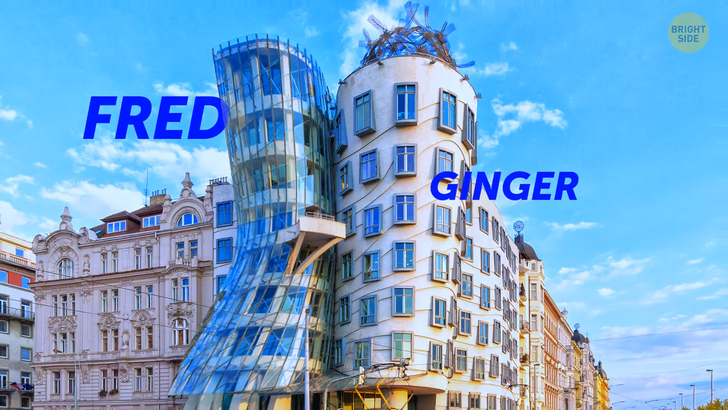
Have you ever wondered what it’s like to be inside a huge carpet? Me neither, but checking out the Azerbaijan National Carpet Museum is definitely worth it, anyway. It shows the history of this important local craft in every detail. Austrian architect Franz Janz designed the construction, and it took 6 years to finish it.
The Basket Building in Ohio looks exactly like a real shopping basket, except it’s 160 times larger. It even has 2 attached handles. The building served as the headquarters of Longaberger Basket Company, then was sold to become a luxury hotel.
A giant whale? An airship? Can you guess what’s inside this building in Graz, Austria? Two British architects won the Europe-wide competition to design this Art Museum. The biomorphic construction has around 1,000 acrylic glass elements on its skin. During the night, it can send light signals and messages to people on the other side of the river. It takes in daylight from the north through the nozzles on its top. The needle is a viewing platform.
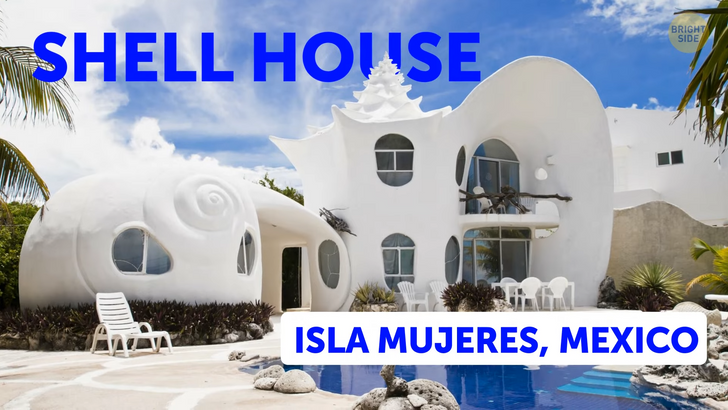
The Half House in Toronto, Canada, was built in the late 19th century and was one of 6 identical houses standing next to each other. When developers came to this area, the owners of all the other houses agreed to move, and this one wouldn’t go. A demolition crew showed some impressive skills as they managed to tear down the neighboring house without doing any damage at all to what is now the Half House. The white exterior wall used to be load-bearing, dividing the neighbors’ bedrooms and living rooms. One wrong move of the excavator, and the entire construction would become ruins.
The Shell House in Isla Mujeres, Mexico, stands by the ocean, was inspired by the ocean, and looks like one of the ocean’s symbols. The house is shell-shaped and covered with shells from nearby beaches. Architect Eduardo Ocampo designed this beauty as he wanted to have a one of a kind house for his brother to come and visit more often. Now it’s up for rent for vacationers.
The Bubble Palace, not far away from Cannes in France, was designed by a Hungarian architect and purchased by Pierre Cardin. In case you have a couple of spare millions, you can buy this interesting property. You’ll get 10 bedroom suites decorated by contemporary artists, gardens, water ponds, a swimming pool, and a 500-seat outdoor auditorium with an awesome view of the Bay of Cannes as a bonus. Can you find one house standing straight here? I know; I also failed.
All the cubes in the Cube House in Rotterdam are tilted 45 degrees at their side. The idea here was to make the most of the space. Dutch architect Piet Blom designed the houses in the late ’70s to look like an abstract forest.
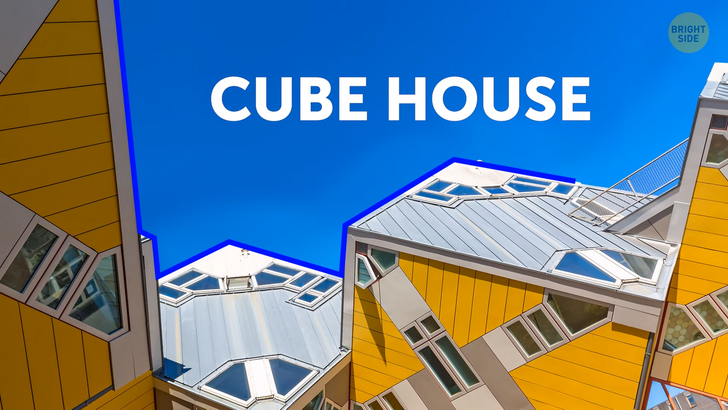
Each triangular roof represents a treetop. The houses stand at 3-floors tall with an entrance on the ground floor, an open kitchen and a living room on the first floor, as well as a bathroom with 2 bedrooms on the top floor.
The Boot in Tasman, New Zealand, is a hotel that looks like it comes straight out of a children’s book. It even has legit shoelaces! There is a spiral staircase, cozy fireplace, kitchenette, and a bedroom with a balcony.
If you ever find yourself in Mitchell, South Dakota, be sure not to miss out on their key tourist attraction — the Corn Palace. The locals have always been so proud of prairie gold that they first built a palace out of corn back in 1892 to prove to the rest of the world how fertile their lands are. What you can see now is the rebuilt version. Every year, they put new corn in 13 shades to form new beautiful murals.











